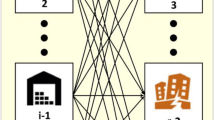Abstract
This paper provides insights to locate a finite number of distribution centers to provide a quick response time for disaster relief incorporating social costs within the modeling framework. We explore theoretical aspects of the problem formulation and propose a model that maximizes coverage of affected regions while minimizing human suffering through the use of a social cost function. Our results show that the social cost function is minimized within the area enclosed by the Voronoi region for a chosen facility. We also propose a heuristic algorithm to solve the problem of locating these facilities in a reasonable amount of time. Since the quality of the solution and the running time depends largely on the initial starting points for the heuristic, we provide recommendations to choose the initial starting points. The proposed approach has the potential to significantly improve the efficiency of distributing critical supplies in disasters by optimizing the response time.



Similar content being viewed by others
Notes
In mathematics, a Voronoi diagram is a special kind of partitioning a space determined by distances to a specific set of points in the same space. In its simplest case, we are given a set of points S in the plane, which are the Voronoi sites. Each site has a Voronoi cell consisting of all points closer to the Voronoi site j than to any other site (see Aurenhammer (1991) for a complete discussion).
A simplex is not degenerate if the matrix Q, formed with the distances of the n edges from one of its vertices, is not a singular.
References
Akkihal AR (2006) Pre-positioning for humanitarian operations. MS Thesis, Massachusetts Institute of Technology
Aurenhammer F (1991) Voronoi Diagrams—A survey of a fundamental geometric data structure. ACM Comput Surv 23(3):345–405
Balcik B, Beamon BM (2008) Facility location in humanitarian relief. Int J Logistics Res Appl 11(2):101–121
BARON Global Optimization Solver. User Manual v. 4.0. Available from: http://www.andrew.cmu.edu/user/ns1b/baron/baron.html
Beamon BM, Balcik B (2008) Performance measurement in humanitarian relief chains. Int J Public Sect Manag 21(1):4–25
Beamon BM, Kotleba SA (2006a) Inventory management support systems for emergency humanitarian relief operations in South Sudan. Int J Logist Manag 17(2):187–212
Beamon BM, Kotleba SA (2006b) Inventory modeling for complex emergencies in humanitarian relief operations. Int J Logistics Res Appl 9(1):1–18
Curtin KM, McCall KH, Qui F (2010) Determining optimal police patrol areas with maximal covering and backup covering location models. Network Spatial Econ 10(1):125–145
Daniele P, Giannesi F, Magueri A (2003) Equilibrium problems and variational models (Nonconvex optimization and its applications). Springer Publications
Daskin MS (1995) Network and discrete location: models, algorithms and applications. Wiley, New York
Drezner Z, Scott CH (2010) Optimizing the location of a production firm. Accepted for Publication in Networks and Spatial Economics
Gabe T, Falk G, McCarty M (2005) Hurricane Katrina: social-demographic characteristics of impacted areas. Congressional Research Service Report for Congress. November 4
Holguín-Veras J, Pérez N, Ukkusuri S, Wachtendorf T, Brown B (2007) Emergency logistics issues in Hurricane Katrina: a synthesis and preliminary suggestions for improvement. Transp Res Rec 2022:76–82
Holguín-Veras J, Pérez N, Jaller M, Destro L, Wachtendorf T (2010) On the need to reformulate humanitarian logistics modeling. In review
Horner MW, Downs JA (2007) A flexible GIS-based network flow model for routing hurricane disaster relief goods. Transp Res Rec 2022:47–54
Horner MW, Downs JA (2008) An analysis of the effects of socio-economic status on hurricane disaster relief plans. Transp Res Rec 2067:1–10
Horner MW, Downs JA (2010) Optimizing hurricane disaster relief goods distribution: model development and application with respect to planning strategies. In press in Disasters: The Journal of Disaster Studies, Policy and Management. doi: 10.1111/j.1467-7717.2010.01171.x
Maliszewski PJ, Horner MW (2010) A spatial modeling framework for siting critical supply infrastructures. The Professional Geographer (In Press)
Mathworks (2010) MATLAB and Simulink for technical computing. www.mathworks.com/. Accessed on March 4, 2010
Nocedal J, Wright S (2006) Numerical optimization. Springer, New York
Okabe A, Boots B, Sugihara K (1992) Spatial tessellations: concepts and applications of Voronoi Diagrams. Wiley, New York
Rawls CG, Turnquist MA (2010) Pre-positioning of emergency supplies for disaster response. Transp Res, Part B: Methodol. In Press
Sheu JB (2007) Challenges of emergency logistics management. Transp Res Part E Logist Trans Rev 43E:655–659
Suzuki A, Drezner Z (1996) The p-center location problem in an area. Location Sci 4(1/2):69–82
Suzuki A, Okabe A (1995) Using Voronoi diagrams. In: Drezner Z (ed) Facility location: a survey of applications and methods. Springer, New York, pp 103–118
Suzuki A, Okabe A (1997) Locational optimization problems solved through Voronoi diagrams. Eur J Oper Res 98:445–456
The Federal Response to Hurricane Katrina (2006) Lessons Learned, Report to the U.S. President, Washington, D.C., February 2006
Tzeng GH, Cheng HJ, Huang TD (2007) Multi-objective optimal planning for designing relief delivery systems. Transp Res Part E Logist Trans Rev 43E(6):673–686
Ukkusuri S, Yushimito WF (2008) A location-routing approach to pre-position supplies in humanitarian supply chains. J Trans Res Rec 2089:18–25
Van Wassenhove LN (2006) Humanitarian aid logistics: supply chain management in high gear. J Oper Res Soc 57(5):475–489
Author information
Authors and Affiliations
Corresponding author
Rights and permissions
About this article
Cite this article
Yushimito, W.F., Jaller, M. & Ukkusuri, S. A Voronoi-Based Heuristic Algorithm for Locating Distribution Centers in Disasters. Netw Spat Econ 12, 21–39 (2012). https://doi.org/10.1007/s11067-010-9140-9
Published:
Issue Date:
DOI: https://doi.org/10.1007/s11067-010-9140-9




